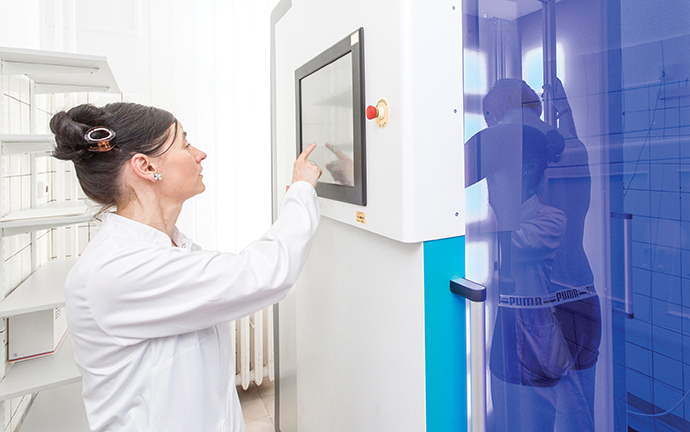Few regions in Germany can make as strong a business case for the health information technology (HIT) industry as Saxony-Anhalt. The state boasts three essential components of the industry: a robust life science and health sector, and equally strong sectors in medical engineering and information and communication technology. Combined with world-class universities in both industries and tens of thousands of students, large manufacturers and small to medium-sized enterprises (SME), and the support system of IMG — Investment and Marketing Corporation Saxony-Anhalt — the economic development agency of the German federal state of Saxony-Anhalt, HIT research and product development is one of the region’s most dynamic industries.
Imagining — and Imaging — New Treatments
Dr. Georg Rose is Chair of Healthcare Telematics at the Otto-von-Guericke University Magdeburg and a member of the executive board of the Forschungcampus [research campus] STIMULATE, focusing on the use of image-guided, minimally invasive tools to both diagnose and treat specific conditions and diseases. STIMULATE is a long-term R&D project funded publicly by Germany’s Ministry of Science and Education and privately by partners like Siemens Healthcare. Rose and his colleagues at STIMULATE want to create an interventional operating room — a “one stop shop” — for acute stroke care using a variety of imaging tools, like angiography featuring high precision computer tomography (CT) imaging, enabling doctors to diagnose and treat patients in the same operating room. “We can help save millions of neurons for the patient,” Rose says.
They’re also looking at ways doctors can use imaging equipment like X-rays, magnetic resonance imaging (MRI) or CT scans to perform surgery — especially for cardiovascular disease or cancerous tumors — in ways that produce minimal injury to the patient. But to use this imaging equipment, researchers need to create dedicated surgical instruments of new materials. Simple, right? Not so fast, says Dr. Rose.
“It depends on the modality,” he says. “For MRI we can’t use metal because of the strong magnets used in the machine, whereas in a CT scanner we prefer to use metal because it can be seen in CT images well. In ultrasound we use plastic tools because plastic is very visible, but plastic or glass can’t be used in the MRI scanner. You can see the body, but you don’t see the instrument.” Researchers also want to develop scanning equipment better suited for imaging surgery, rather than the large diagnostic machines. While their work is pure research, other HIT companies in Saxony-Anhalt are already bringing health tech products to market.
A Better Understanding
In 2009 Dornheim Medical Images was founded by Lars Dornheim, the developer of software that creates vivid, 3-D anatomical images which can be rotated on screen giving physicians and technicians a 360-degree view of things like tumors. The images greatly enhance a doctor’s ability to diagnose medical problems, with an important secondary benefit. “Patients understand it better,” says Dornheim. “Everybody can visually understand 3-D data if it’s shown in the right way.”
Health IT research and product development is one of the
region’s most dynamic industries.
It’s also possible to construct 3-D models using the software. “You can prepare for an ear operation, for example, where you’re putting in a cochlear implant, on an artificial model, which looks exactly like the real bone,” says Dornheim. The company received some high-profile attention in 2014 when an operational model of the ear bone created using Dornheim Medical Images technology was awarded the Hugo Junkers Innovation Award of the state of Saxony-Anhalt.
Dornheim Medical Images is one of two tech firms working with Dr. Harald Gollnick at the Fraunhofer Institute for Factory Operation and Automation IFF Magdeburg to develop a full body scanner for early detection of skin cancer (see photo). The prototype, which can scan 90 percent of the patient’s body, is now in use at the Magdeburg University Clinic for Dermatology and Venereology.
Harnessing Information
These days, there is more data than medical researchers can possibly read. How can they sort through the millions of documents, and where would they even begin? Enter OntoChem. Dr. Lutz Weber is the CEO of the Halle-based company founded in 2005. He and his team created what might best be described as a dynamic search engine of substance properties for use in pharmaceuticals, cosmetics and other personal care products. Information is gleaned from global scientific journals, books, websites, even package inserts of medications.
But it’s more than just information gathering; the search engine understands context. “One of the basic differences of our search engine versus things like Google is that we are searching for concepts,” says Weber. “You’re searching in a more abstract way. If you type ‘plant’ in Google, you will get a completely different result as opposed to our concept search.”
In addition to researching and developing products on its own, OntoChem provides reports to companies engaged in product development. “Imagine you’re a life sciences company that wants to do something in the field of inflammation in the skin,” says Weber. “You could ask our system, ‘What are the most used plants or natural plants products with the most anti-inflammatory activity?’ ” The information can be sorted and ranked, and offers guidance to companies looking to add natural ingredients to their new products.
Education and research institutions play a big part in Saxony-Anhalt’s success in HIT. “There are a lot of interesting places, but Magdeburg is an interesting place for the things that we do,” says Dornheim. “There is a high density of research institutes for medical imaging. We have a very big university hospital and a good technical university with a long, long tradition. We know our partners personally and the time to market is shorter because we can test quickly. We also have a lot of good focused students.”
It’s not without good reason, then, that global IT players like IBM, Dell or T-Systems have successfully established themselves in Saxony-Anhalt.
This Investment Profile was prepared under the auspices of the Investment and Marketing Corp. of Saxony-Anhalt. For more information, contact Dr. Carlhans Uhle, Managing Director, at +49 391 568 990 or by email at welcome@img-sachsen-anhalt.de. On the Web, go to www.invest-in-saxony-anhalt.com.

